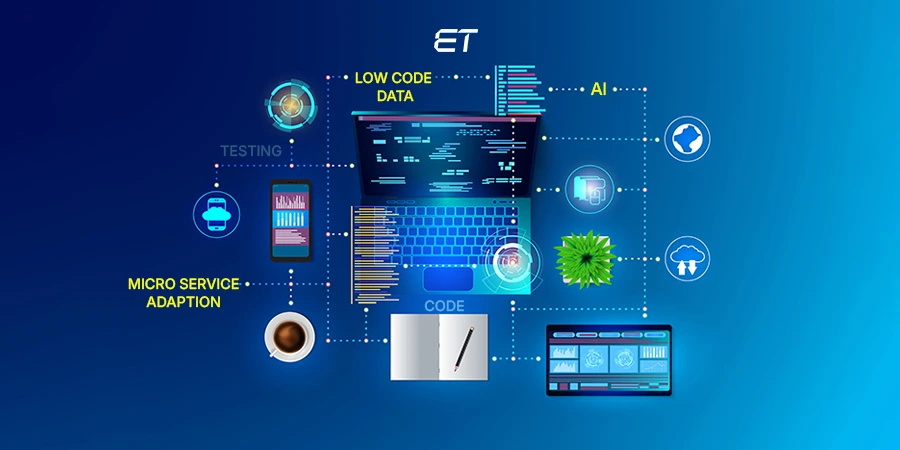
Azure Microservices: Comprehensive Insights for CTOs
As a CTO, your chief focus to elevate productivity can include architecture choices like Azure microservices. So, if you’re one such C-level executive, it’s vital to read ahead.
Across the globe, CTOs prefer the Azure microservices architecture for specific reasons. These services optimize cloud resources, reduce the risk of introducing bugs, and enable the building of scalable applications.
But are these reasons the sole drivers for choosing microservices in Azure?
In a word, no. Banking on Azure has several long-term impacts on these scalable and agile services. So, without any ado, we present some vital insights into banking on Azure and plan a fool-proof technical strategy.
A Quick Look at Azure Microservices

In simple words, Azure microservices refers to building software applications on Microsoft’s Azure cloud platform.
Developers use the microservices architectural style to build such applications.
Microservices communicate with each other to deliver full application functionality. Here are the main facets of these small blocks:
- They are small and independent
- Microservices rely on well-defined interfaces to communicate
- You can develop microservices using various programming languages and frameworks
Overall, Azure microservices are scalable, agile, resilient, and maintainable. In addition, choosing the Azure cloud platform offers the following advantages:
- Pre-built Services: Azure offers a library of services you can integrate into your microservices
- Management Tools: This Microsoft offering provides tools to streamline deployment, management, and monitoring
- Cloud Scalability: You can quickly scale your microservices up or down to meet resource demands
So, by choosing Azure microservices, you can take software development to a desirable level that suits today’s competitive development landscape.

Want to discuss how Azure can fit in your development lifecycle? Contact us today!
Business Benefits of Using Azure Microservices
As a CTO, your chief focus will always be on making informed decisions that help your business grow exponentially. So, in this section, we’ll explain how Azure microservices can work in your favor from a corporate point of view.
1. High Agility and Innovation

With microservices, each service is a self-contained unit. This aspect allows developers to work, test, and deploy individual services independently without affecting the entire application.
This freedom of software advancement reduces development cycles compared to monolithic applications. In addition, microservices break down complex applications into smaller, more manageable codebases. So, developers can focus on their specific area of expertise, leading to faster development and fewer bugs.
Now, choosing an Azure microservice architecture can help your business quickly get new features and functionalities into users’ hands. So, you can capitalize on relevant market opportunities and stay ahead of the competition.

Speaking of agile, you can implement specific strategies to develop fixed-cost projects. Get Agile Strategies for Development for useful insights on this topic.
2. Robust Scalability and Resilience

With Azure’s cloud capabilities, Microservices architecture offers significant advantages in scaling your application to meet fluctuating demands.
For instance, if a particular service experiences a surge in traffic, you can scale it without affecting other services. This aspect optimizes resource utilization and avoids unnecessary costs for modifying the entire application.
Furthermore, Azure microservices prevent cascading failures. This term means that if one service encounters an issue, it’s isolated from other services. Such an architecture style minimizes the overall impact on the application. So, users might experience a temporary disruption in a specific functionality, but the entire application remains operational.
3. Bolstered Maintainability

Here’s the main deal – microservices break down large codebases into smaller, well-defined units. This division allows dedicated developers to focus on a specific area of functionality. So the code is easier to understand, debug, and modify.
It’s logical to perceive that smaller, well-defined microservices are more accessible to test in isolation. For instance, you can develop unit and integration tests more efficiently, leading to higher code quality and fewer bugs in production.
All in all, these aspects lead to improved maintainability, which translates to lower development costs. Also, Azure DevOps provides a suite of tools for CI/CD pipelines, automated testing, and code repositories. These tools streamline the development process and facilitate faster deployments for individual Azure microservices.

Need to know how microservices differ from serverless architecture? Then, refer our informative blog here.
How to Build Microservices in Azure?

As a CTO, you know the potential of Azure microservices architectures for agility, scalability, and maintainability.
So, from your perspective, it’s essential to focus on the following aspects:
- Planning
- Design
- Development
- Deployment
- Security considerations
- Azure optimization
In this section, we’ll explain all the above stages to help you utilize Azure microservices effectively.
Planning and Design
First, you should analyze your application domain to identify natural boundaries for separating functionalities into independent Azure microservices.
For this purpose, you should consider factors like business capabilities, data ownership, and deployment frequency. Next, choose the programming languages, frameworks, and containerization technologies that are suitable for your development team’s skills and each microservice’s specific needs.

Looking for latest info on the best microservices frameworks? Then read Best Microservices Framework Guide now!
Development and Deployment
As a CTO, it is essential to develop each Azure microservice as an independent unit with its codebase, deployment process, and lifecycle management.
Microsoft Azure offers valuable services, such as Azure Functions or AKS. You can also implement a robust CI/CD pipeline using Azure DevOps to automate code building, testing, and deployment for each microservice.
It’s crucial to establish comprehensive monitoring using Azure Monitor to track individual microservices’ health, performance, and logs. This facet enables proactive identification and troubleshooting of issues.
Security Considerations
It’s vital to implement robust authentication and authorization mechanisms. This way, you can control access to each Azure microservice’s APIs. Furthermore, Azure Active Directory (MS Entra ID) provides centralized identity and access management for your microservices.
To bolster your network security, you can follow the best practices to restrict Azure microservices access. Tools like Azure Firewall and Network Security Groups can prove handy in such cases.

Need quick insights on bolstering your front-end security? Get Front-End Security Best Practices Now!
Azure Microservices Optimization
To take advantage of Azure’s managed services like AKS, Azure App Service, and Azure Functions, you can conduct some practical optimizations.
For instance, you can utilize Azure Cost Management tools to monitor and optimize resource consumption for your Azure microservices. Also, the pay-as-you-go pricing allows you to scale cost-effectively based on actual usage.
Overall, you need to build a DevOps culture within your organization that emphasizes collaboration, automation, and continuous improvement.
Implementing Azure Microservices: Challenges for CTOs

Well, everything’s not perfect about implementing any technology, right?
Despite the many positive aspects of an Azure microservice architecture, you must also consider the challenges. So, here are some crucial aspects to consider, presented in a tabular format.
| Challenge | Explanation |
| High complexity | To implement Azure microservices, CTOs like you need to invest in proper service discovery mechanisms, API management solutions, and distributed tracing tools to ensure smooth operation |
| Prone to cyber threats | Microservices introduce a wider range of potential entry points for attackers. So, you must prioritize robust security measures like proper authentication, authorization, and encryption at the service level |
| Debugging issues | In a distributed system with many interacting microservices, debugging flaws can be time-consuming. So, as a CTO, you should establish clear logging practices and utilize distributed tracing tools to pinpoint the source of problems |
| Integration hindrances | Integrating existing monolithic applications with Azure microservices can be complex. So, there is a need to develop a well-defined strategy for phased migration or API integration |
| Staff training | Azure microservices development requires a different skillset and development culture compared to monolithic applications. So, you might need to invest in training or hire developers with experience |
Should CTOs Implement Azure Microservices?
As a CTO, it makes sense to leverage the benefits of Azure microservices. These independent components can capitalize on their architecture’s strengths and make the most of Azure’s splendid cloud environment.
If you want improved agility, an innovative approach to software development, and leverage open-source technologies, Azure microservices can be a good choice. With these evident benefits, you can build scalable apps that are convenient for end users.
However, as a CTO, you must follow a systematic process to implement these microservices. Planning, designing, deploying, and installing robust security measures is a vital workflow for implementing the Azure microservices architecture. A handy suggestion is to keep on optimizing this technology for cost and performance.
Adopting these microservices is often fraught with challenges, such as complexity, cyber threats, debugging issues, and integration. You also need to train your developers to maximize the use of available resources. To decrease this hassle, contact our experienced team, well-versed in developing customized Azure microservices.
Frequently Asked Questions on Azure Microservices
1. What’s the best thing about an Azure microservice architecture?
Event-driven programming is one of the best aspects of managing microservices in Azure. This credit goes to Microsoft Azure’s ergonomic and useful cloud-based environment.
2. How is monolithic architecture different from microservices?
In monolithic architecture, developers build an application as a single unified unit. On the contrary, microservices architecture focuses on creating independent, small, deployable services.





